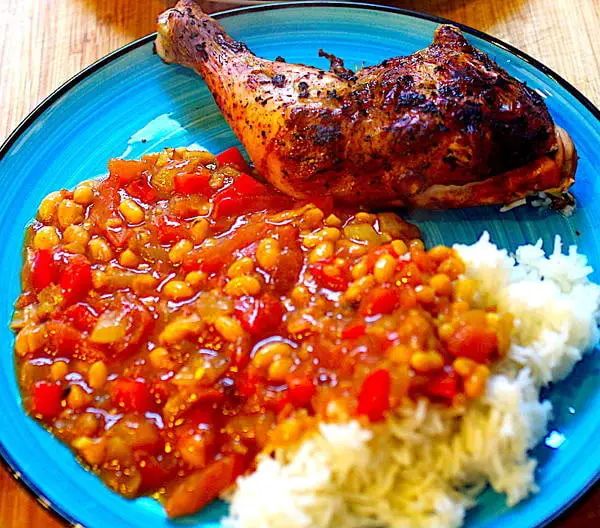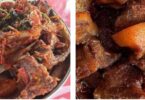African food is distinct and as diverse as the continent its self. It is a medley of African ingredients and some foreign additions that have found themselves in Africa in different ways. Some are a direct result of its complicated past with traders and colonizers. A serving of African food is as good as a journey back through time. If you pay particular attention to the ingredients, you might be able to connect the dots.
Table of Contents
Boerewors

Boerewors. Photo/Food.com
It is a dish that originated in South Africa. Boer is a farmer in Dutch, and wors means sausage, so farmers’ sausage is a South African speciality. You put this coil-shaped sausage on a braai or barbeque. You can accompany it with a spicy sauce. You can have it as a hot dog by putting it in a bun and topping it with tomato and onion.
The flavour is a mix of spices and salt. It has various levels of spiciness and saltiness, depending on the components used.
Chakalaka

Chakalaka. Photo/The Food Dictator
Chakalaka is a spicy vegetable dish. You make it with tomato, onion, carrot, bean, bell pepper, ginger, and chili. This dish is another popular addition to South African cuisine.
This dish has its origins in Johannesburg, where it is a common meal. It’s often mixed with greens and served cold as a salad or with amasi (thick sour milk) and bread.
It’s even a popular addition to many South African barbecues as a tasty side dish. Aside from the predominant spiciness, the dish’s flavour varies depending on the vegetables and spices used.
Bunny Chow

Bunny Chow. Photo/Curious Cuisiniere
This cuisine has its origins in Durban, South Africa, where the Indian community resides. You stuff a half or quarter loaf of bread with a bean, chicken, mutton, or egg curry.
Non-vegetarian varieties of rabbit chow have appeared in recent years. This is even though the traditional bunny chow was entirely vegetarian. Stuffing options include sausage, cheese, eggs, and chips. You can serve it with a carrot-chilli-onion salad or pickled lemon, mango, or vegetables.
The gravy soaking the bread walls is one of the common characteristics of this gigantic appetizer. Two people often share it. Initially, they would sell them wrapped in newspaper. Now bunny boxes have taken their place. This keeps the curry heated while also reducing the possibility of it leaking.
Bobotie
Bobotie is a meat dish that you can cook using lamb, ground beef, or pig. Curry powder, spices, herbs, and vinegar are a few of the other ingredients. Some recipes include raisins and apricots, walnuts, bananas, and spicy chutney (sauce) as garnishes. The baked egg perched on the cake is the cherry on top.
The flavour is rich, with a mix of sweet, salty, and spicy notes. It has a silky, moist feel thanks to the egg custard, with every bite melting into your tongue in an instant. It’s a popular menu dish in most South African restaurants. You can serve it with yellow rice (rice mixed with turmeric).
Koshary

Koshary. Photo/Cairo360
Egypt’s national cuisine, koshary or kosheri, is a popular street meal that dates back to the mid-nineteenth century. Rice, lentils, and macaroni are the essential ingredients in this recipe. Toppings include a hot tomato or chilli-based sauce and wine vinegar. These toppings bring forth the full flavor of the dish. The majority of garnishes involve frying onions and chickpeas.
Its name is a literal translation of the Indian cuisine khichdi. This also includes lentils and rice. Despite its reputation as a poor man’s dish, you will now find it in fine dining establishments.
Alloco

Alloco. Photo/Pinterest
Alloco is a West and East African fried plantain meal. It has garlic, parsley, tomato, onion, green pepper, and black pepper. The most common accompaniments include baked chicken, fried chicken, fried fish, or boiled eggs. The sweetness of the plantains takes center stage. It blends with the spiciness of the sauces to create a mouthful of fire.
Gatsby

Gatsby. Photo/V&A Waterfront
The Gatsby is a popular South African submarine sandwich. It consists of a bread roll loaded with French fries and various sauces. Sausage, poultry, pickled or fried fish, and curries are some of the other things you can use as stuffing. Pickle dressings or sauces on the fillings add a spicy, acidic flavor.
This dish came by happenstance in 1976 in Cape Town, South Africa. It happened when a shop owner packed a round bread loaf with chips, sausage, and pickle. He gave it to his workers who were refurbishing his shop.
Banga soup
Banga soup is a delectable Nigerian soup. You make it with palm fruit, vegetables, beef, fish, and seasonings like chile pepper and salt. It was traditionally served with fufu, although you can also have it with rice or flatbreads. The sweet-tart flavor of palm fruit, mixed with the meat’s richness, would make the soup quite tasty.
Shiro
Shiro is just another addition to Africa’s plethora of stews and soups. The significant components are wide beans or chickpeas. The popular toppings include garlic, diced tomatoes, ground ginger, chili pepper, and onions to enhance the dish’s flavor.
You can eat it with Injera, or leavened flatbread, and kitcha, or unleavened flatbread. You create the highly spicy tegabino shiro by boiling legumes, chickpeas, and water in a clay pot. This is only one of the different variants of Shiro. You typically have Shiro during religious holidays such as Ramadan and Lent.
Hoenderpastei
Hoenderpastei is a delicious chicken pie. It has layers of veggies, eggs, and hams prepared with a shortcrust pastry. The filled pastry gets a brown colour and crunchy flavour by baking it at medium heat in the oven.








